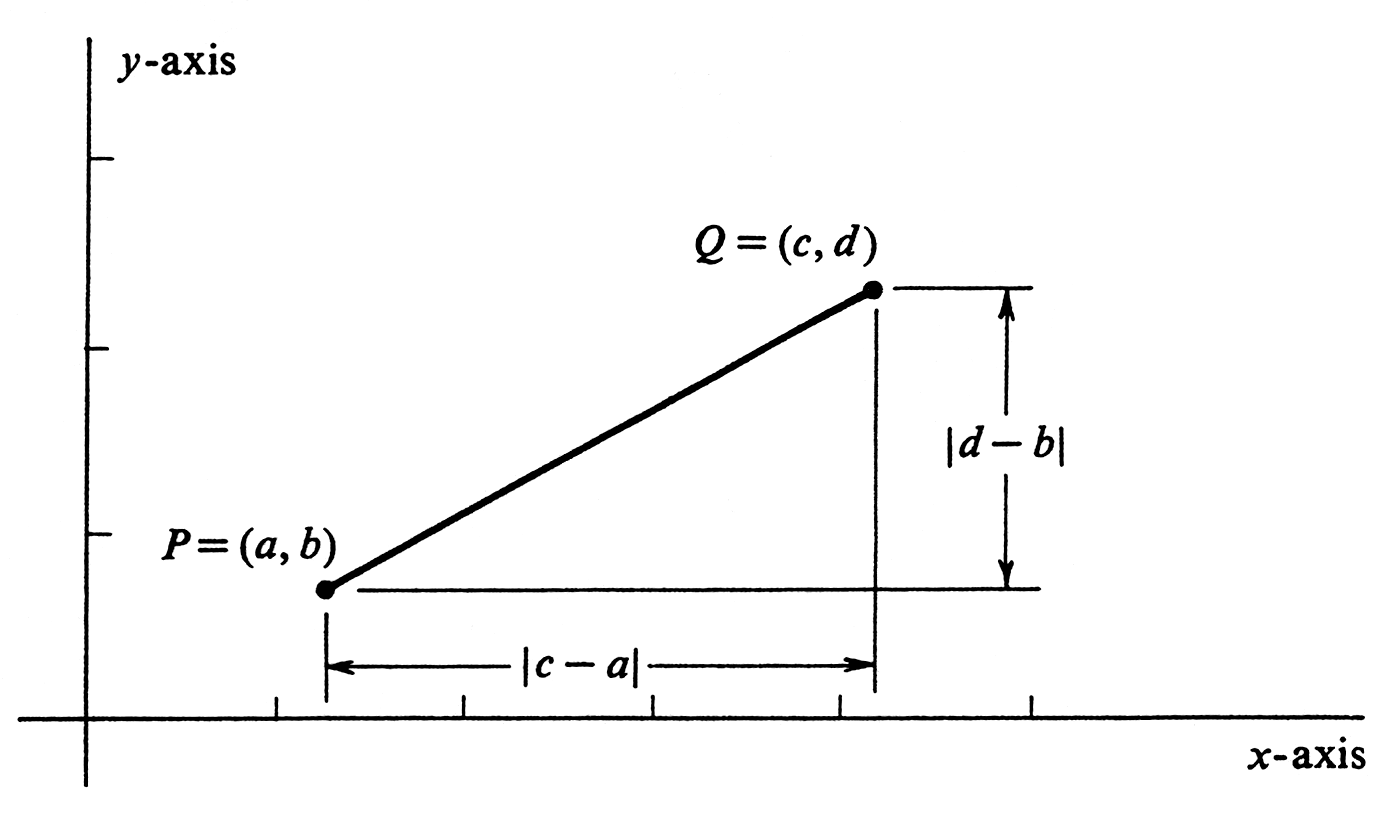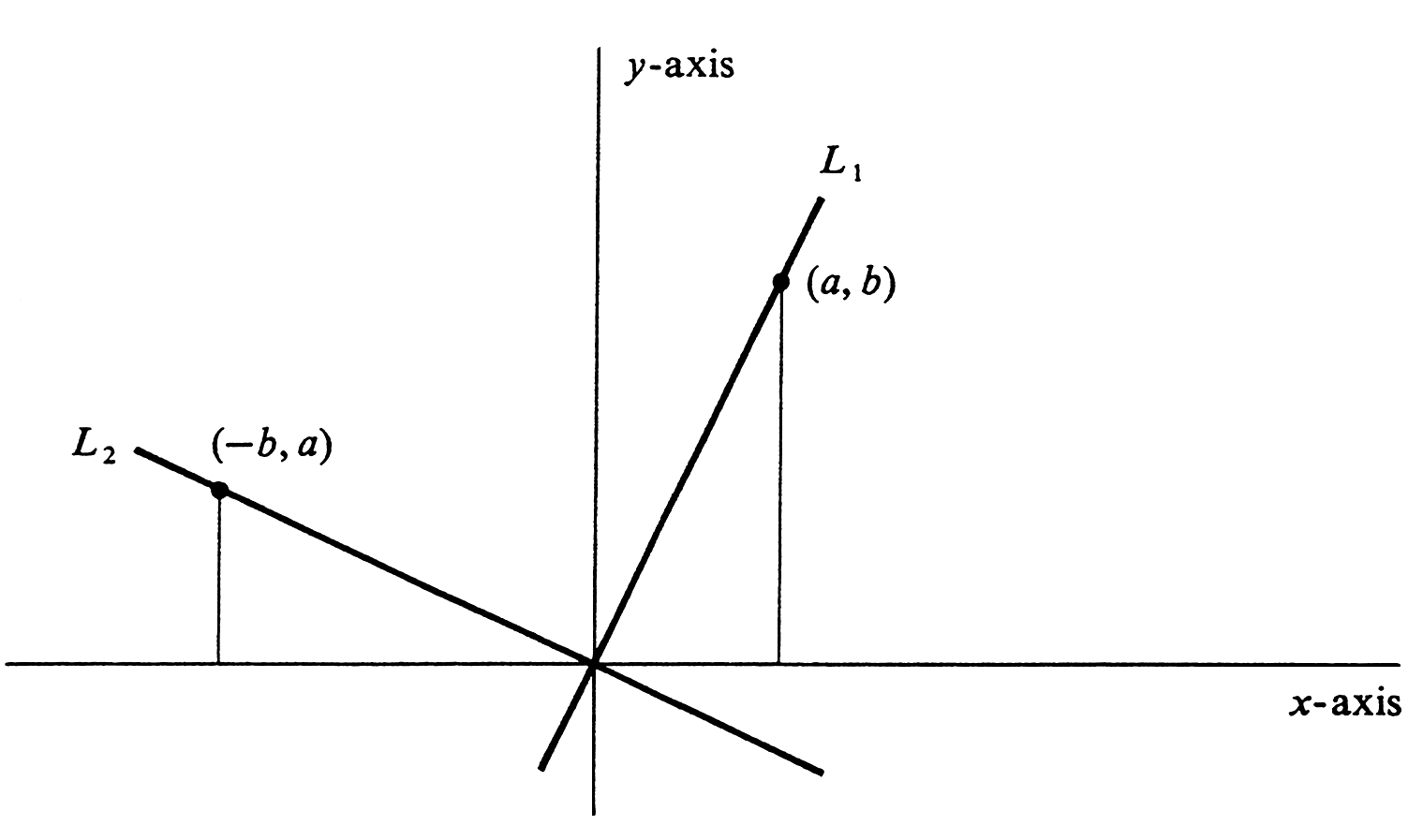guide:0d227dcd1c: Difference between revisions
mNo edit summary |
mNo edit summary |
||
| (One intermediate revision by the same user not shown) | |||
| Line 180: | Line 180: | ||
'''Example''' | '''Example''' | ||
Find an equation of the straight line <math>L</math> through the point <math>(a, b)</math> and with slope <math>m</math>. | Find an equation of the straight line <math>L</math> through the point <math>(a, b)</math> and with slope <math>m</math>. | ||
If <math>(x, y)</math> is any other point on the line, then | If <math>(x, y)</math> is any other point on the line, then | ||
| Line 222: | Line 222: | ||
Suppose that <math>S</math> is an arbitrary subset of <math>\R^2</math> with the following three properties: | Suppose that <math>S</math> is an arbitrary subset of <math>\R^2</math> with the following three properties: | ||
#<math>S</math> contains a point <math>(a, b)</math>; i.e., <math>S</math> is a nonempty set. | |||
# The slope <math>m(P, Q)</math> is defined and is equal to the same fixed number <math>m</math>, for every pair of distinct points <math>P</math> and <math>Q</math> in <math>S</math>. | |||
#<math>S</math> contains every point <math>(x, y)</math> in <math>\R^2</math> which is connected to <math>(a, b)</math> by a line segment of slope <math>m</math>. | |||
These are certainly the geometric properties of a nonvertical straight line. | These are certainly the geometric properties of a nonvertical straight line. | ||
| Line 248: | Line 248: | ||
'''Example''' | '''Example''' | ||
(a) Write an equation of the straight line <math>L_1</math> that passes through <math>(-2, 4)</math> and (3, 7). | (a) Write an equation of the straight line <math>L_1</math> that passes through <math>(-2, 4)</math> and (3, 7). | ||
(b) Write an equation of the line <math>L_2</math> passing through <math>(5, -2)</math> and parallel to <math>L_1</math>. | (b) Write an equation of the line <math>L_2</math> passing through <math>(5, -2)</math> and parallel to <math>L_1</math>. | ||
| Line 257: | Line 257: | ||
<math display="block"> | <math display="block"> | ||
\frac{y - 7}{x - 3} = \frac{3}{5}. | \frac{y - 7}{x - 3} = \frac{3}{5}. | ||
</math> | |||
Hence an equation defining | |||
Hence an equation defining <math>L_1</math> is <math>5(y - 7) = 3(x - 3)</math>, or, equivalently, | |||
<math display="block"> | <math display="block"> | ||
3x - 5y + 26 = 0. | 3x - 5y + 26 = 0. | ||
</math> | </math> | ||
The line <math>L_2</math> also has slope 5. | |||
Since it passes through <math>(5, -2)</math>, it is defined by | The line <math>L_2</math> also has slope 5. Since it passes through <math>(5, -2)</math>, it is defined by | ||
<math display="block"> | <math display="block"> | ||
\frac{y + 2}{x - 5} = \frac{3}{5} \;\;\; \mbox{if} \;\;\; x \neq 5, | \frac{y + 2}{x - 5} = \frac{3}{5} \;\;\; \mbox{if} \;\;\; x \neq 5, | ||
</math> | </math> | ||
or, more generally, by <math>5(y + 2) = 3(x - 5)</math>, which is equivalent to | or, more generally, by <math>5(y + 2) = 3(x - 5)</math>, which is equivalent to | ||
Latest revision as of 23:40, 3 November 2024
We shall define a straight line in [math]\R^2[/math] to be any subset [math]L[/math] consisting of all ordered pairs [math](x, y)[/math] such that
The inequality [math]a^2 + b^2 \gt 0[/math] simply says that the constants [math]a[/math] and [math]b[/math] are not both equal to zero. Of course two different equations can define the same line. For example, the set of all ordered pairs [math](x, y)[/math] such that [math]4x - 3y + 5 = 0[/math] is the same line as the set of pairs for which [math]28x = 21y - 35[/math]. For this reason, we speak of an equation of a straight line and not the equation.
Suppose that straight lines [math]L_1[/math] and [math]L_2[/math] are defined, respectioely, by
If such a [math]k[/math] exists, then the two equations are equivalent, and so [math]L_1 = L_2[/math]. Conversely, suppose that [math]L_1 = L_2[/math]. We may assume without loss of generality that [math]b_{1} \neq 0[/math]. Then the point [math]\Bigl(0, -\frac{c_1}{b_1} \Bigr)[/math] lies on [math]L_1[/math] since it satisfies the first equation; i.e.,
One consequence of Theorem is that it enables us to recognize at a glance whether or not different equations define the same straight line. Another corollary arises in connection with the following definitions: A line [math]L[/math] defined by an equation [math]ax + by + c = 0[/math] with [math]a^2 + b^2 \gt 0[/math] will be called vertical if [math]b = 0[/math] and horizontal if [math]a = 0[/math]. It follows from the theorem that [math]b[/math] must equal zero for every such equation which defines a vertical line and that [math]a[/math] must equal zero for every such equation which defines a horizontal line. Thus the definitions are not dependent on the particular equation which defines [math]L[/math]. If [math]P = (a, b)[/math] and [math]Q = (c, d)[/math] are two points in [math]\R^2[/math] and [math]a \neq c[/math], the slope of the line segment joining [math]P[/math] to [math]Q[/math] is, by definition,
Note that
The absolute value of [math]m(P, Q)[/math] is the ratio of the vertical to horizontal distance between [math]P[/math] and [math]Q[/math] (see Figure). It is simply a measure of steepness. A segment with positive slope goes up as it goes to the right; one with negative slope goes down as it goes to the right (Figure). If [math]a = c[/math], the segment is vertical, and the slope is not defined.
Let [math]L[/math] be the straight line defined by the equation [math]ax + by + c = 0[/math], where [math]b \neq 0[/math]. If [math]P[/math] and [math]Q[/math] are any two distinct points on the line, then [math]m(P, Q) = -\frac{a}{b}[/math].
Let [math]P = (x_1, y_1)[/math] and [math]Q = (x_2, y_2)[/math]. An equation equivalent to the original one is
As a result of Theorem and Theorem, we can unambiguously define the slope of a nonvertical line [math]L[/math], which we shall denote by [math]m_{L}[/math], as follows: For any pair of distinct points [math]P[/math] and [math]Q[/math] on [math]L[/math], we define
It follows at once that [math]m_{L}[/math] depends only on the line [math]L[/math]. For if [math]P'[/math] and [math]Q'[/math] are any other two distinct points on the line, then
(Since [math]L[/math] is not vertical, [math]b \neq 0[/math].) Furthermore, any other equation defining [math]L[/math] can be written [math]kax + kby + kc = 0[/math] with [math]k \neq 0[/math], and, of course, [math]-\frac{ka}{kb} = -\frac{a}{b}[/math]. We note that the slope of a vertical line is not defined.
Example
Find an equation of the straight line [math]L[/math] through the point [math](a, b)[/math] and with slope [math]m[/math].
If [math](x, y)[/math] is any other point on the line, then
Suppose that [math]S[/math] is an arbitrary subset of [math]\R^2[/math] with the following three properties:
- [math]S[/math] contains a point [math](a, b)[/math]; i.e., [math]S[/math] is a nonempty set.
- The slope [math]m(P, Q)[/math] is defined and is equal to the same fixed number [math]m[/math], for every pair of distinct points [math]P[/math] and [math]Q[/math] in [math]S[/math].
- [math]S[/math] contains every point [math](x, y)[/math] in [math]\R^2[/math] which is connected to [math](a, b)[/math] by a line segment of slope [math]m[/math].
These are certainly the geometric properties of a nonvertical straight line. It follows from (i) and (ii) that the coordinates of every point [math](x, y)[/math] in [math]S[/math] satisfy the equation
Two nonvertical lines [math]L_1[/math] and [math]L_2[/math] with slopes [math]m_1[/math] and [math]m_2[/math], respectively, are perpendicular if and only if [math]m_{1}m_{2} = -1[/math].
Example
(a) Write an equation of the straight line [math]L_1[/math] that passes through [math](-2, 4)[/math] and (3, 7).
(b) Write an equation of the line [math]L_2[/math] passing through [math](5, -2)[/math] and parallel to [math]L_1[/math].
(c) Write an equation defining the line [math]L_3[/math] that passes through [math](-1, -3)[/math] and is perpendicular to [math]L_1[/math].
The slope of the segment joining [math](-2, 4)[/math] and (3, 7) is [math]\frac{7 - 4}{3 + 2} = \frac{3}{5}[/math].
An arbitrary point [math](x, y)[/math] other than (3, 7) belongs to [math]L_1[/math] if and only if
Hence an equation defining [math]L_1[/math] is [math]5(y - 7) = 3(x - 3)[/math], or, equivalently,
The line [math]L_2[/math] also has slope 5. Since it passes through [math](5, -2)[/math], it is defined by
or, more generally, by [math]5(y + 2) = 3(x - 5)[/math], which is equivalent to
What functions have graphs that are straight lines? The answer is an easy one. If [math]f[/math] is defined by
General references
Doyle, Peter G. (2008). "Crowell and Slesnick's Calculus with Analytic Geometry" (PDF). Retrieved Oct 29, 2024.


